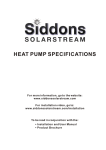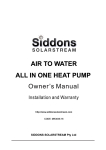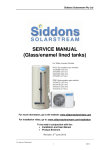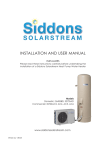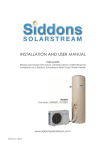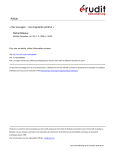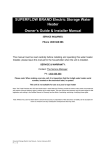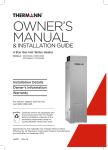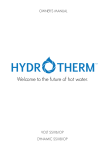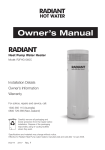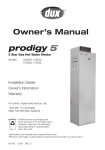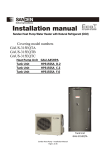Download Siddons Solarstream MAHRW010ZB Owner`s manual
Transcript
AIR TO WATER HEAT PUMP WATER HEATER Owner s Manual BOLT-ON split system models: MAHRW010ZB/P MAHRW010ZB-250SS MAHRW010ZB-315SS MAHRW010ZB-250VEO MAHRW010ZB-315VEO without tank stainless steel tank stainless steel tank vitreous enamel tank vitreous enamel tank http://www.siddonssolarstream.com CODE:MK4068-02 SIDDONS SOLARSTREAM Pty Ltd AIR TO WATER HEAT PUMP WATER HEATER Contents 1. One of the World's Most Efficient Ways to Heat Water....................................... 4 1.1 Introduction................................................................................................ 4 1.2 Dynamic Cycle Flow Heating System.............................................................4 1.3 Reduce Greenhouse Emissions................................................................... 4 1.4 Specifications.............................................................................................. 5 1.5 Schematic................................................................................................... 6 2. Installation Details........................................................................................... 6 2.1 General Installation Requirements............................................................. 6 2.2 Not suitable for Pools and Spas................................................................... 6 2.3 Heat Pump Positioning................................................................................ 6 2.4 Evaporator Drain......................................................................................... 7 2.5 Water Pipe Connections .............................................................................. 7 2.6 Electrical Connection ................................................................................. 8 2.7 Storage Tank Positioning............................................................................ 9 2.8 Outdoor Installations.................................................................................. 9 2.9 Indoor Installations..................................................................................... 9 2.10 Siesmic Restraint...................................................................................... 9 2.11 Filling the Storage Tank............................................................................. 9 2.12 Legionella.................................................................................................10 2.13 Scalding................................................................................................... 10 2.14 Pressure Limiting Valve............................................................................ 10 2.15 Cold Water Expansion Control Valve.........................................................10 2.16 Stop / Isolating Valve................................................................................ 10 2.17 Pressure and Temperature Relief Valve .................................................... 10 2.18 Hot Water Connection.............................................................................. 11 2.19 Tempering Valves.................................................................................... 11 2.20 Plumbing Components QIK Kit................................................................. 11 2.21 Corrosion Protection .............................................................................. 12 3. Operating Instructions................................................................................... 12 3.1 Powering Up............................................................................................... 12 3.2 Pressure and Temperature Relief Valve Maintenance.................................. 12 3.3 Water Quality.............................................................................................. 13 3.4 Anode.........................................................................................................13 3.5 Draining the tank........................................................................................ 13 1 AIR TO WATER HEAT PUMP WATER HEATER Contents 4. Storage Tank Specifications........................................................................... 14 4.1 Stainless Steel Storage Tank Models.......................................................... 14 4.2 Glass Lined / Vitreous Enamel Storage Tank Models................................... 14 5. Safety Information...........................................................................................14 5.1 Safety Devices........................................................................................... 14 5.2 Water Heater Unused for Long Periods ....................................................... 15 6. Maintainance & Service Information................................................................ 15 6.1 No Puncturing the Water Tank ................................................................... 15 6.2 Cleaning the Evaporator Coils................................................................... 15 6.3 Sacrificial Anode....................................................................................... 15 6.4 Capacitors................................................................................................. 15 7. Routine Service.............................................................................................. 16 7.1 Access and removal of Sacrifical Anode.................................................... 16 7.2 Flushing of Water Tank.............................................................................. 16 7.3 Thermal Overload (Incorporated in Digital Controller) .............................. 16 8. Operation & Adjustment of the Digital Controller............................................. 16 8.1 Optional Mounting and Fixing of the Remote Controller........... ............... 17 8.2 Use of remote controller ........................................................................... 17 8.2a The user interface and function shows as below.................................... 17 8.2b Initial Power On and Standby Status..................................................... 18 8.2c ON/OFF Control.................................................................................... 18 8.2d Electric Heater Control......................................................................... 18 . 8.2 e Turning On/Off the Ring Main Water Circulating Pump Manually.... ................ 19 8.2f Clock Setting......................................................................................... 19 8.2g Timer 1 ON/OFF Setting..........................................................................19 8.2h Setting of Timer 2, Ring Main Water Supply Flow and Return Line ................... 19 8.2i Cancellation of Timing Setting Operation ............................................... 20 8.2j Parameter Setting .................................................................................. 20 8.3 Operation Data Setting............................................................................................ 21 9. Recognition of Abnormal Operation............................................................... 22 9.1 Pressure & Temperature Relief Valve Running........................................... 22 9.1a Continuous Trickle................................................................................ 22 9.1b Steady Flow........................................................................................... 22 9.2 No Hot Water............................................................................................ 22 2 AIR TO WATER HEAT PUMP WATER HEATER Contents 10. System Malfunction Schedule............................................................................ 23 11. Judgement and Solution of Malfunctions........................................................24 12. Wiring Diagram.............................................................................................. 25 13. Warranty Policy (Australia Only).................................................................... 26 13.1 Warranty Terms......................................................................................... 26 13.2 Warranty Conditions................................................................................. 26 13.3 Exclusions................................................................................................ 27 13.4 Water Quality Limits - Warranty Exclusion................................................. 27 13.5 How to make a Warranty Claim................................................................... 28 13.6 Tanamet Crystal Water Filters................................................................... 28 13.7 Australian Consumer Law......................................................................... 28 3 AIR TO WATER HEAT PUMP WATER HEATER 1. One of the World's Most Efficient Ways to Heat Water 1.1 Introduction Congratulations on purchasing a SIDDONS Solarstream energy efficient Heat Pump Water Heater, designed for Australian conditions to produce many years of low energy hot water. This water heater typically uses up to 75% less energy than a conventional electric element water heater by absorbing heat from the surrounding air of between -5 and 45 degrees C, night and day. It works in hail, rain and shine and becomes more efficient as the air temperature and humidity rise. You can expect around 20% greater efficiency per 10 degree rise in the ambient air temperature. SIDDONS, with its partners, designs and manufactures energy efficient Heat Pump Water Heaters for global markets using the best quality components sourced from Australia, Germany, Japan and China. Heat Pump Water Heaters can be used for factories, schools, hotels, motels, restaurants, hospitals, beauty salons, spas, laundries, etc. 1.2 Dynamic Cycle Flow Heating System The Dynamic Cycle flow heating system is used to convert an average of 1 kW/h of input electrical energy into 3.5 kW/h of heat energy, more or less, depending on ambient air temperature and humidity. Cold water from the bottom of the storage tank is cycled through the heat exchanger in the Heat Pump outdoor unit then back to the storage tank until all the water is completely heated. As the name implies, an air to water Heat Pump Water Heater is a machine that pumps or transfers heat absorbed from the ambient air into the water. Even at - 5 deg C, there is enough heat in the air to boil the liquid refrigerant into a gas. Once in the form of a gas, it can be compressed to superheat up to 95 deg C; this heat is then pumped into the water through a double layered, tube inside tube heat exchanger. One tube takes the hot compressed gas whilst the other takes the cold water from the tank. The advantages of this method are: · Excellent heating efficiency · Stable hot water without over heating at the top or under heating at the bottom · All of the tank water is heated 1.3 Reduce Greenhouse Emissions With a SIDDONS Solarstream, you are greatly assisting the reduction of global greenhouse gas emissions if you can replace bottled gas, wood fired or a conventional electric element water heater, the latter typically consumes 1/4 to 1/3 of a household's power usage. If you want your water heater to be completely carbon neutral, then also install a small electricity generating system such as a Photo Voltaic solar panel or wind power. 4 AIR TO WATER HEAT PUMP WATER HEATER 1.4 Specifications Model Nomenclature MA HR W S - * ** - W A B / P S (B D) Source medium MA: Air source MW: Ground source D: With electrical heating (Without electrical heating omitted) B: Inverter E: EVI Function of the unit HR: Heating (Without inverter or EVI omitted) Energy exchange medium A: Refrigerant W: Water S: 3phase (single phase omitted) P: With built in pump (without built in pump omitted) S: With solar (Without solar omitted) A: Coil heating B: Circulating heating The figure represents the horse power of unit eg: 010 means 1 horse power A: Horizontal fan direction B: Upward fan direction C: Double air duct type Z: Integrated type W: Split type(indoor unit ) Model Number Rated Heating Capacity (1) Rated Input Power (1) Rated Input Current (1) Rated COP (1) Rated Heating Capacity (2) Rated Input Power (2) Rated Input Current (2) Rated COP (2) Hot Water Recovery Rate (average) Maximum input current Power Supply Maximum water inlet temperature Maximum water outlet temperature Noise Compressor type Water Outlet/Water Inlet Water Flow Volume Refrigerant type Heat Pump Dimensions (L/M/H) Shipping Dimensions (L/M/H) Heat Pump Weight Shipping Weight MAHRW010ZB/P kW 3.5 kW 0.97 A 4.4 W/W 3.6 kW 2.8 kW 0.84 A 3.8 W/W 3.3 L/h 75 A 6.6 V/PH/Hz 220/1/50 deg C 55 deg C 60 dB(A) 48 Rotary Inch 3/4 m3/h 0.6 R134A mm 590/540/690 mm 640/590/725 kg 55 kg 60 Notes: Scenario (1): Outdoor air temp Dry Bulb 20 / Wet Bulb 15 deg C Scenario (2): Outdoor air temp Dry Bulb 7 / Wet Bulb 6 deg C Water tank temp rise 40 deg C 5 AIR TO WATER HEAT PUMP WATER HEATER 1.5 Schematic Appearance and Mounting Dimensions B Units: mm MAHRW Size A A B C D D 010ZB/(P) 566 180 540 690 C Note: For water pipe connection instructions, refer section 2.5 below. 2. Installation Details 2.1 General Installation Requirements This water heater must be installed by a licensed trades person in accordance with: 1). AS 3500.4, National Plumbing And Drainage Code, Part 4: Hot Water Supply Systems 2). AS 3500.4.2, National Plumbing And Drainage Code, Part 4.2: Hot Water Supply Systems Acceptable Solutions 3). Other relevant Australian Standards, Industry or Local Water Supply regulations or codes for mains pressure storage tanks Note: This water heater is not suitable for pool heating or building heating. 2.2 Not suitable for Pools and Spas Note, this heat pump is not suitable for pool or spa heating due to the high levels of salt and/or chlorine used and volume of water to be heated. If used for such applications, your warranty will be void. 2.3 Heat Pump Positioning The heat pump extracts heat from the air being drawn through the fin coils of the evaporator. This produces cold outlet air as a by-product. In order for the heat pump to operate efficiently, good ventilation is required to extract the heat from the air easily and therefore the heat pump is best located outside. The cold exhaust air should not be allowed to feed back into the inlet or operational efficiency will be reduced. The heat pump should not facing into a prevailing wind. However, alternate locations may be used such as a large double garage (minimum of 120 cubic metres). The R134a refrigerant used has a boiling point of minus 26 deg C so there is no risk of damage to the heat pump from frost. Performance may be reduced in very low temperatures but the system will not be damaged by such climatic conditions. 6 AIR TO WATER HEAT PUMP WATER HEATER Wrong Right Notice: 1) Keep enough space around the unit for maintenance access with at least 200mm of clear space for evaporator coils so there is good air flow into the evaporator. 2) Ensure the heat pump is sited onto a flat, level surface. Use a 600mm x 600mm concrete slab if the installation base is not solid. 3) Install the metal feet of the heat pump onto the rubber feet supplied and bolt it onto the base. 4) It is a good idea to install the heat pump with some weather protection such as an eave to protect against direct sunlight which may make the fan blade brittle over time. 5) Protect the heat pump from salt spray if near the coast as this will reduce its operating life. 6) Ensure there is space above the heat pump for the outlet air to blow upwards unimpeded. 7) The heat pump and storage tank may be installed on a balcony, roof, floor or other convenient place but you must ensure your site has load-bearing to cope with the weight as specified plus the weight of the water inside the storage tank (1kg per litre). 8) During operation, condensate water will flow from the evaporator so use a length of hose connected to the drain hole elbow to take the condensate water to a drain. 9) If your only option is to locate the heat pump inside a large internal space such as a garage, this space should be well ventilated or the heat pump will turn it into a cool room and your heating efficiency will decrease (keep in mind that a 10 degree C reduction in air temperature will cause approximately 20% lower efficiency). 2.4 Evaporator Drain During operation, considerable amounts of condensate water will flow from the evaporator drain. If allowed to simply flow out of the outlet, this water may pool below the unit and can cause problems to both the water heater and area around it. The evaporator drain should be properly drained using a length of hose or pipe in accordance with regulations but must not be connected directly to the PTR valve or expansion valve drain. 2.5 Water Pipe Connections 1) Water pipe connections should be heat-resistant, rust-proof, resist fouling and conform to national health and safety standards. The water pipe can be stainless steel pipe, copper pipe, aluminium water pipe, hot water PPR pipes, etc. 2) Ensure all water pipes are clean and rust free to prevent pipe blockage. 3) The water circulating pipes from the heat pump should be installed with the least amount of bending and distance from the water storage tank for optimum efficiency. We recommend between 2m to 5m as an ideal distance for the water circulating pipes. 7 AIR TO WATER HEAT PUMP WATER HEATER 4) The water outlet of the heat pump should connect to the hot water outlet port of the storage tank. 5) Ensure that all the pipes are tightly connected and test for leaks. 6) Apply insulation onto the pipes and plumbing fittings to minimise heat loss. Water Circulating Pipe Connection Instructions: Hot water Hot water Cold water Cold water Option A: Single set of water inlet/outlet ports Use a Tee Piece and one-way valve on both pipes to add the water circulating pipe connections between the heat pump and water storage tank. Option B: Single set of water inlet/outlet ports plus ring main return port Use a Tee Piece and one-way valve on inlet cold water pipe from the water storage tank to add the water circulating inlet pipe to the heat pump with return water flowing back to the middle ring main port on the water storage tank. Hot water Option C: Double set of water inlet/outlet ports plus ring main return port Connect the heat pump water circulating inlet pipe to the spare cold water inlet port on the water storage tank with return water flowing back to the middle ring main port. Cold water 2.6 Electrical Connection SIDDONS water heaters are designed for single-phase 220/240V A/C supply only. A certified electrician must carry out all electrical work in accordance with regulations including AS3000. A 15-amp circuit breaker should be installed at the power supply for the hot water unit. A separate circuit breaker is recommended for each unit in the case of multiple installations. The connection will require an approved, standard 240V 15A On / Off isolating switch or Junction Box in close proximity to the heater. Key points: 1) The heat pump should ideally be supplied with a dedicated 240 Volt 15 Amp power supply 2) The heat pump should ideally be connected using a 15 Amp power cable 3) The heat pump power supply circuit must have a grounding wire 4) Power lines and signal lines should be neat and rational, with strong and weak lines separated so they cannot interfere with each other; leave appropriate distance between the lines 5) Electrical maintenance must be done by qualified technicians (refer to circuit diagram below) 6) Unit control panel Code MK4068 7) Fuse specifications: 5A/250V 8 ) The appliance must be installed in accordance with regulations 8 AIR TO WATER HEAT PUMP WATER HEATER Electric wire selection: Mode Host Power Phase line Zero line Ground line Max.line length (m) Signal line 010ZB/(P) 220V/1PH/50Hz 1.0mm2 1.0mm2 1.0mm2 15 0.5mm 2 Max.line Tem. sensor assistance line length (m) 0.5mm 2 50 2.7. Storage Tank Positioning For all models, it is best to install the storage tank close to the water outlet that has the greatest usage of hot water, such as the kitchen, laundry or bathroom. Ensure adequate access for service to the sensor and Pressure and Temperature Relief (PTR) valve. Ensure the specification label is visible. For glass/enamel storage tank models, leave adequate clearance above the appliance, preferably the length of the water heater, for inspection or service to the anode through the top of the tank. If adequate room is unavailable, this appliance must be disconnected and removed for service. For stainless steel storage tank models, this requirement isn't important as there is no anode to change. It is recommended that hot water outlet pipes are fully insulated with weather proof insulation such as Armaflex. The hot water outlet pipe should be angled down at about 15 minimum for the first 250mm after exiting from the storage tank outlet. This will create a heat trap that will avoid any thermal siphoning from the storage tank. It is normal for the PTR valve to discharge water, especially after the heating cycle has completed and this should be discharged into a drain, clear of paved areas to prevent possible damage or injury, in accordance with regulations. 2.8. Outdoor Installations For outdoor (external) installations, a 100mm thick plinth or concrete base pad is recommended in accordance with Australian Standard AS/NZS 3500.4 to properly support the storage tank such that the storage tank is assured of remaining in a vertical position throughout its usable life and not lean over due to possible erosion of soil under the plinth, or such risk. 2.9. Indoor Installations For indoor (internal) installations, the storage tank should be installed onto a safe tray with drain hose connected to a drain, in accordance with regulations. 2.10. Siesmic Restraint If you live in an area subject to seismic building code, you must restrain the tank to a wall using Stainless Steel bands that do not pierce the tank. 2.11. Filling the Storage Tank Fill the water storage tank by opening all hot water taps and also the isolating valve on the water inlet pipe. Let the cold water flow into the storage tank until it is full. The air in the water pipes will be expelled through the opened hot water taps. Let the water flow out of the hot water taps for a few minutes to completely expel all of the air in the water pipes then close each of the hot water taps. Check the pipes and plumbing fittings for any water leaks. If no water leaks, then the water heater is ready to be turned on. If the heat pump continues operating for approximately 5 minutes, then it is functioning satisfactorily. 9 AIR TO WATER HEAT PUMP WATER HEATER If the heat pump stops operating within 5 minutes, then air is still likely trapped in the water pipes. Power off the heat pump and open the hot water taps again for a few more minutes to let the water flow out, then power up the heat pump again. Follow the above process again if the heat pump does continue operating. Alternately, remove the flat base plate from the heat pump underneath the curved corner plate to reveal the water pump. Turn the centre screw to release air, then re-tighten and replace the base plate. 2.12. Legionella To kill legionella bacteria that may grow in potable water, AS 3498 requires that a storage type water heater raise the water temperature at the hot water outlet to at least 60 degree C. Therefore, we recommend that you leave your Solarstream switched on when you are away, where it will typically turn on for a short run every several days to raise the water temperature in the tank back to 60 degree C. 2.13. Scalding To minimize scalding, especially for those people in high scald risk categories such as young children, people with potentially incapacitating medical conditions and elderly people, the Solarstream must be installed in accordance with the Australian Standard AS/NZS3500.5. This will ensure that new hot water installations deliver tempered water not exceeding 50 degree C to bathrooms and other locations used primarily for personal hygiene purposes. 2.14. Pressure Limiting Valve This water heater is designed for connection to a maximum water supply pressure of 500kPa. Where the mains pressure can exceed or fluctuate beyond this pressure, a Pressure Limiting Valve complying with AS1357 must be fitted to the cold-water supply line. This device must be installed after the stop / isolating valve and set at 500kPa. Failure to install this device correctly will void your warranty and likely cause damage to your water storage tank, plumbing components and fittings. It will also cause malfunctioning of the PTR and ECV valves. 2.15. Cold Water Expansion Control Valve A Cold Water Expansion Control Valve (ECV) should be fitted when the water supply has a tendency to form scale. This type of water is referred to as hard water or scaling water because calcium carbonate is deposited out of the water onto any hot metallic surface. The fitting of an ECV is mandatory in WA, SA and some other areas of Australia for this reason as per local regulations. If you don't have a water supply from a mountain reservoir, then check this point with your plumber. The ECV should be rated at 700kPa, 200kPa more than the Pressure Limiting Valve, and 150kPa less than the PTR Valve. 2.16. Stop / Isolating Valve An approved stop / isolating valve, non-return valve, line strainer (optional but recom mended), and union must be fitted between the main supply and the inlet socket of the water storage tank. 2.17 Pressure and Temperature Relief Valve The Pressure and Temperature Relief (PTR) valve is designed to relieve the increased water pressure during the normal heating cycle of the water heater. 10 AIR TO WATER HEAT PUMP WATER HEATER The Pressure and Temperature relief valve, which is supplied with the unit, must be fitted and made accessible so that the release mechanism can be operated and, if required through malfunction / wear and tear, the PTR valve should be replaced. The outlet of the PTR valve must be suitably drained to remove the water discharged during the normal heating cycle in accordance with regulations. Warning: A separate drain line must be run for the PTR valve. It is not permitted to couple the drain lines from the PTR valve and evaporator into a single common line. It is acceptable to use a tundish under the evaporator drain connected to the drain of the PTR valve. 2.18. Hot Water Connection The hot water pipe be connection is to a G3/4 / 25mm socket as shown in the Installation Diagram. NOTE: Plugs are supplied with the water heater to plug off the inlet / outlet ports that are not required. Ensure that adequate sealing tape is applied to the plugs for a tight, leak proof seal. We recommend insulating the unused inlet / outlet ports. 2.19. Tempering Valves We recommend high quality, solar rated tempering valves fitted onto the hot water outlet for supply of tempered water to 50 degrees C, as per regulations, to bathrooms, etc. 2.20. Plumbing Components QIK Kit The components of the QIK Kit have been designed to meet Australian plumbing regulations including insulating gloves on components. SIDDONS recommends the Siddons Solarstream QIK Kit (QIK15-SHP) or equivalent for quality plumbing components for longer life of your Solarstream Water Heater and better installation. Water contains minerals which can cause problems especially when heated. Also, high water pressure will reduce tank life so the QIK Kit contains a pressure limiting valve rated to 2,000 kPa that will deliver water to the storage tank at an easy 500kPa. This will deliver good water pressure but not excessive pressure that will waste water and shorten tank life. The 3 way Tee is designed to supply both cold and hot water to the Tempering Valve. The inlet Tee is designed to incorporate the Pressure Limiting Valve, the Non-return Isolating Valve and the cold water Expansion Control Valve as well as supplying cold water to the cold side of the Tempering Valve. 11 AIR TO WATER HEAT PUMP WATER HEATER DO NOT DRILL ANY HOLES INTO THE STORAGE TANK CASING. IT MAY CAUSE DAMAGE OR LEAKAGE TO THE STORAGE WATER TANK INSIDE AND VOID YOUR WARRANTY 2.21 Corrosion Protection Fittings to the casing in contact with the water must be galvanically compatible. Sealants and / or Teflon plumbing tape should be used on potentially galvanically incompatible fittings. This is to protect against possible electrolytic corrosion between the metals (where moisture penetration could occur due to incorrectly or poorly sealed fittings). 3. Operating Instructions 3.1. Powering Up Use the ON/OFF button on the digital controller to power up the unit. If the heat pump continues operating for approximately 5 minutes, then it is functioning satisfactorily. If the heat pump stops operating within 5 minutes, then air is still likely to be trapped in the water pipes. Power off the heat pump and open the hot water taps again for a few more minutes to let the water flow out, then power up the unit again following the above process. 3.2. Pressure and Temperature Relief Valve Maintenance The Pressure and Temperature Relief (PTR) valve lever should be operated at least once a year to ensure that the water-ways are clear and to remove any mineral deposits from the valve seat that may cause the PTR valve to leak. When manually operating the lever, water will discharge. Avoid contact with the hot water to avoid potential scalding. 12 AIR TO WATER HEAT PUMP WATER HEATER If no water flows, the PTR valve is inoperative. Turn off the water heater and call a plumber immediately. The PTR valve is designed for emergency safety relief only. 3.3. Water Quality Your Solarstream has been manufactured to suit the water conditions of Australia, which is the driest continent on Earth and subject to extended periods of drought. This can cause water supplies to become mineralised, which can have a detrimental effect on your storage tank and its life expectancy. Additionally, if you use a rain water supply, this may be acidic and therefore require pH balancing for longer life. In general, we recommend a stainless steel storage tank for pure water coming from mountain fed reservoirs and a glass/enamel lined steel tank for all other areas. Our warranty policy sets out the water quality limits for stainless steel and glass/enamel lined steel storage tanks. R efer section 13.4 Water Quality Limits - Warranty Exclusion 3.4. Anode For glass/enamel storage tank versions, your Solarstream is fitted with a magnesium (cap colour code 'Black') anode as standard. For hard /scaling water areas, we recommend an aluminium alloy anode for hard water (cap colour code 'Blue'). The anode should be examined or replaced once every 5 years by a licensed plumber to ensure its ongoing protection of your storage tank. Your Solarstream should always be switched on to avoid possible accumulation of hydrogen gas which is flammable and may accumulate in the system. This may be observed as 'spluttering' when a hot tap is opened initially. To dissipate this gas safely, we recommend that a hot tap be turned on for several minutes or until the gas discharge ceases. Use a sink, basin or bath outlet, but not at a dishwasher, clothes washer or other appliance. During this procedure, there must be no smoking, open flame, or any electrical appliance operating nearby. If hydrogen is discharged through the tap, it will probably ' make an unusual sound similar to air escaping. 3.5. Draining the tank Consideration should be given to draining the tank occasionally, particularly if your water supply is mineralised or hard/scaling. To do this, connect a hose to the cold water inlet and run it to a suitable drain. It will be necessary to disconnect the hot water outlet or PTR valve to relieve any partial vacuum created as the water flows out. 13 AIR TO WATER HEAT PUMP WATER HEATER 4. Storage Tank Specifications 4.1 Stainless Steel Storage Tank Models Model MAHRW010ZB-250SS MAHRW010ZB-315SS Litres Capacity 327 264 mm A Height 1980 1620 mm B Diameter 580 580 mm C Hot Water Outlet 1491 1136 mm D Cold Water Inlet 186 168 Kg Dry Weight 73 62 kPa Inlet Water Pressure 500 kPa PTR Valve (supplied) 850 Cold Water Expansion Valve kPa 700 Water Connections 20mm,3/4 inch BSP Material Type Stainless steel (316 marine grade) 4.2 Glass Lined / Vitreous Enamel Storage Tank Models Model MAHRW010ZB-250VEO MAHRW010ZB-
































